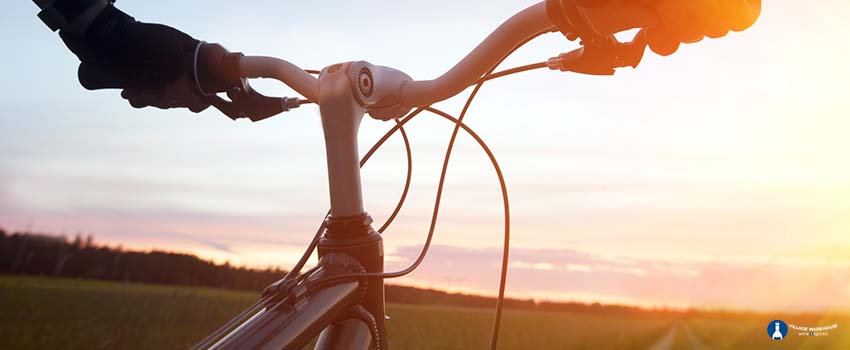Mountain biking is an engaging activity that combines physical fitness, mental challenge, and social interaction.
Mountain bikers enjoy the freedom of exploring nature while also getting exercise. You get to see amazing views, experience the thrill of speed, and feel the wind in your face.
If you’re just getting started, it might seem intimidating. There are many types of trails, and each type of terrain presents its challenges. Some trails require technical skills, while others are designed for beginner riders to know how to ride a mountain bike correctly.
No matter what kind of trail you’re planning to tackle, some mountain biking tips for beginners will help you become a confident rider. Whether you’re a seasoned pro or a complete novice, these mountain biking tips for beginners should help you get started on the right foot. And remember, the more you ride, the easier it gets.
Essential Safety Gears for Mountain Biking
You don’t have to go all out and buy every piece of top-tier gear, but there are a few mountain biking basics you must have.
1. Helmet
If you’re riding off-road, you’ll need to invest in a mountain bike helmet. These helmets are designed to cover more of your head and give better protection in the event of a crash.
2. Mountain Bike Specific Shoes
This is going to change everything. You won’t believe how much grip you’ll get when you pair mountain bike shoes with pedals. It will feel as if you are glued to the platform.
3. Mountain Bike Shorts
Mountain bike shorts were made to provide optimum comfort and flexibility without being overly baggy. They’re also constructed of a thicker material that can resist a rugged terrain.
4. Knee Pads
Knee pads are the second most important piece of protective equipment. They will not only assist with grazes and harsh impacts to the knees, but they will also protect you from the inevitable pedal strikes.
Factors to Consider in your Bike Setup
Bike setup is all about finding what works best for you. Aside from buying the best mountain bike for beginners, many different variables can affect your ride, including your height, weight, and riding style. Here’s a list of things to consider when setting up your bike.
1. Height and placement of the saddle
One of the most crucial mountain biking basics is to ensure the correct saddle height. You can pay for a bike fit to get a more precise measurement, but it’s pretty simple to estimate on your own. Your leg should not be straight when your foot is on the pedal at six o clock but it should have a tiny bend. You shouldn’t have to reach to the bottom of the pedal stroke, and you shouldn’t be squatting in an uncomfortable position.
2. Tire inflation pressure
Tire pressure that is too high or too low might ruin your ride. Too much will prevent you from finding traction, while too little will result in your tires folding and your rims colliding with roots and pebbles. Tire pressure varies depending on terrain conditions and rider weight, so getting an accurate estimate is difficult.
3. Suspension
You should also be aware of your fork and shocks. Setting the air pressure and sag is the first step. The weight of the rider will determine this. Rebound and compression adjustments will be available on the suspension.
4. Simple to maintain
It’s critical to keep your bicycle clean and in functioning order. Even if your bike doesn’t appear dusty, it’s worth cleaning key components like the gears and suspension and dropper post seals. To do this, all you need is a yard hose and some degreaser. Lubricate your chain after washing your bike or after it dries.
Mountain Biking Tips you Need to Know
1. Correctly position your body
Even if you buy the best mountain bike for beginners, it will be rendered meaningless if you begin in the incorrect basic position. It would be best if you placed the pedals horizontally by placing the balls of your feet squarely in front of the pedal axis. Then, to absorb bumps and shocks from uneven terrain, keep your knees and arms slightly bent. You should keep your back straight always.
2. Keep your gaze forward
When you first start mountain biking, one of the most typical mistakes is looking down instead of straight ahead. However, foresight is half the battle when it comes to mountain biking. If you are serious about learning how to ride a mountain bike, you must know how to avoid falling by keeping your view far enough ahead.
3. Get off the saddle
Even while staying in the seat always appears to be quite comfortable at first, it might lead to falls, especially when riding downhill. This happens because you’re not using your legs when you’re in the saddle. Remember that getting off the saddle not only helps you absorb hits better but also helps you better transfer your weight.
4. Make good use of your brakes
Braking is not easy, and getting the appropriate feel for the braking force takes some experience. Always remember to put one finger on each brake so that you can apply regulated force to both brakes simultaneously. If it’s possible, distribute your weight evenly across both wheels to ensure that neither wheel locks.
Conclusion
To advance in life, you must be consistent in all you do. Consistency will not only help you remember these beginner’s mountain biking tips, but it will also teach you the most vital skill, which is “Experience.” Consider all the vital information and tips mentioned above to keep your ride an enjoyable and safe one.
Let Village Warehouse Wines and Spirits be a part of your mountain biking experience.
Mountain biking is a great outdoor activity that you can do anywhere to unwind or even work out your body. However, as a beginner, you should follow the basic mountain biking tips to keep you safe. And to cap off your adventure, it is only natural to want to quench your thirst and rejuvenate yourself with a cold bottle of beer after a challenging day of cycling. So, after your ride, drop by at Avon liquor store to quench your thirst with our wide variety of beers and celebrate your new-found sport with us.





